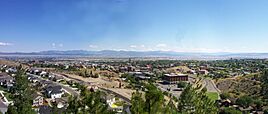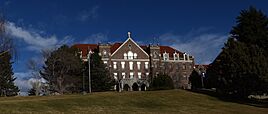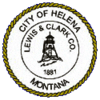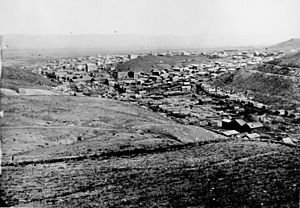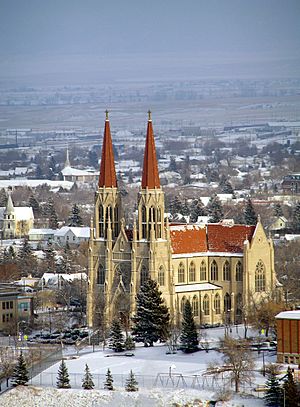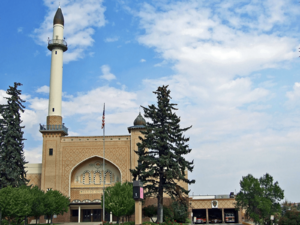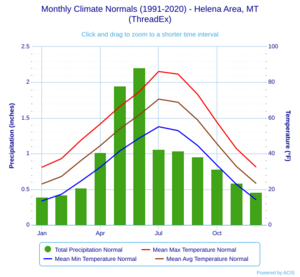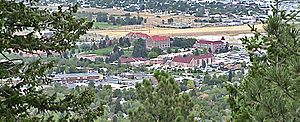Helena, Montana facts for kids
Quick facts for kids
Helena
|
|||
|---|---|---|---|
|
Helena skyline
Benton Avenue Cemetery
Original Montana Governor's Mansion
Carroll College
|
|||
|
|||
| Nickname(s):
Queen City of the Rockies, The Capital City
|
|||
| Country | United States | ||
| State | Montana | ||
| County | Lewis and Clark | ||
| Founded | October 30, 1864 | ||
| Government | |||
| • Type | City | ||
| Area | |||
| • State capital | 16.90 sq mi (43.76 km2) | ||
| • Land | 16.86 sq mi (43.67 km2) | ||
| • Water | 0.04 sq mi (0.10 km2) | ||
| • Urban | 11 sq mi (30 km2) | ||
| Elevation | 3,996 ft (1,218 m) | ||
| Population
(2020)
|
|||
| • State capital | 32,091 | ||
| • Density | 1,903.38/sq mi (734.91/km2) | ||
| • Metro | 83,058 | ||
| Time zone | UTC−7 (Mountain) | ||
| • Summer (DST) | UTC−6 (Mountain) | ||
| ZIP Codes |
59601–59602, 59626; 59604, 59620, 59624 (P.O. Boxes); 59623, 59625 (organizations)
|
||
| Area code(s) | 406 | ||
| FIPS code | 30-35600 | ||
| GNIS ID | 2410734 | ||
| Waterways | Tenmile Creek | ||
Helena is the capital city of Montana, a state in the United States. It is also the main city of Lewis and Clark County.
Helena started as a gold mining camp on October 30, 1864. Because of the gold rush, it quickly became a very rich city. By 1888, about 50 millionaires lived there! This wealth helped build many beautiful Victorian style buildings.
In 2020, Helena had about 32,091 people. This makes it the 6th largest city in Montana. It is also one of the least populated state capitals in the U.S. The main newspaper is the Independent Record. The city has its own airport, Helena Regional Airport.
Contents
History of Helena
The area around Helena was home to different indigenous peoples for a very long time. More than 10,000 years ago, people from the Folsom culture lived here. Later, groups like the Salish and Blackfeet visited the area. They moved around with the seasons.
Gold Rush and Early Days
In the early 1800s, people from the U.S. and Canada came to look for fur-bearing animals. They explored the rivers, passing through what is now Helena.
Major gold rushes happened in Idaho in the early 1860s. This brought many people to the area. In May 1864, the U.S. government created Montana Territory. On July 14, 1864, a group called the "Four Georgians" found gold. They found it in a gulch (a small valley) they named "Last Chance Gulch." This led to the start of Helena.
By the fall of 1864, over 200 people lived there. They thought "Last Chance" was not a good name. On October 30, 1864, a group met to name the town. They also planned the streets. One man suggested "Helena" after a town in Minnesota. Others wanted to name it after Helena, Arkansas. The name "Helena" won, but people said it differently for a while. By 1882, the pronunciation "HEL-i-nuh" became the most common.
In 1865, Captain John Wood surveyed Helena. The first streets followed old mining paths. This is why some city blocks in old Helena have different sizes and shapes.
In 1870, Henry D. Washburn led an expedition from Helena. They explored the area that would become Yellowstone National Park. Many Helena residents were part of this important trip.
A City of Wealth
By 1888, Helena had more millionaires per person than any other city in the world. They earned their money from gold. It's believed that about $3.6 billion (in today's money) was found in Helena. Much of the gold was found in the "Last Chance Placer." This is one of the most famous gold deposits in the western U.S. Today, much of this area is under Helena's streets.
The city's great wealth led to the building of many beautiful homes. These Victorian buildings show how rich the city was during the gold rush.
Helena's official symbol is "The Guardian of the Gulch." This is a wooden fire watch tower built in 1886. It still stands on Tower Hill. It was built to help spot fires after many big fires swept through the early mining camp. In 2016, the tower was damaged by fire. It will be rebuilt using the same old methods.
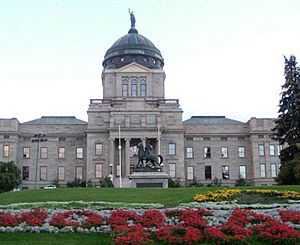
In 1889, Charles Arthur Broadwater opened his Hotel Broadwater and Natatorium. The Natatorium had the world's first indoor swimming pool. It closed in 1941 after an earthquake. Today, a fitness center with an outdoor pool heated by natural springs stands nearby.
Helena has been the capital of Montana Territory since 1875. It became the state capital of Montana in 1889. The Montana State Capitol building was finished in 1902. Until 1900, Helena was the biggest city in Montana.
In 2017, Helena voters elected Wilmot Collins as mayor. He was a refugee from Liberia. He was Helena's first Black mayor.
Modern Helena Activities
The Cathedral of Saint Helena and the Helena Civic Center are important historic buildings. Many people in Helena work for the state government.
Visitors often enjoy the walking mall downtown. It was built in the 1980s. A small artificial stream runs along the mall. It represents the natural springs that once flowed there.
The Archie Bray Foundation is a famous ceramics center. It is located near Helena.
Helena is great for outdoor activities. You can go hunting and fishing. The Great Divide Ski Area is close by. Helena is also known for its mountain biking. It was named an "International Mountain Bicycling Association Ride Center" in 2013.
Helena has two public high schools: Helena High School and Capital High School.
Geography and Climate
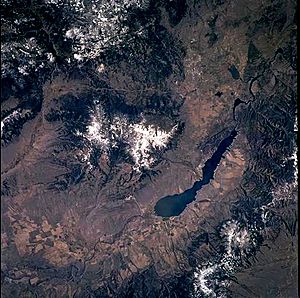
Helena is located at an altitude of about 4,058 feet (1,237 meters).
The city is surrounded by many natural features. These include the Continental Divide, Mount Helena City Park, Spring Meadow Lake State Park, and Lake Helena. There are also the Helena National Forest, the Big Belt Mountains, and the Missouri River.
Helena has a semi-arid climate. This means it has long, cold, and snowy winters. Summers are hot and dry. Spring and autumn are short. Snow can fall in any month except July. However, it usually falls from October to April. Winters can have warmer periods due to chinook winds. The city gets about 11.4 inches (290 mm) of rain each year. Most of the rain falls in the spring.
The hottest temperature recorded in Helena was 105°F (41°C). This happened on August 24, 1969, and July 15, 2002. The coldest temperature was -42°F (-41°C). This happened on January 31, 1893, January 25, 1957, and February 2, 1996.
Population and People
| Historical population | |||
|---|---|---|---|
| Census | Pop. | %± | |
| 1870 | 3,106 | — | |
| 1880 | 3,624 | 16.7% | |
| 1890 | 13,834 | 281.7% | |
| 1900 | 10,770 | −22.1% | |
| 1910 | 12,515 | 16.2% | |
| 1920 | 12,037 | −3.8% | |
| 1930 | 11,803 | −1.9% | |
| 1940 | 15,056 | 27.6% | |
| 1950 | 17,581 | 16.8% | |
| 1960 | 20,227 | 15.1% | |
| 1970 | 22,730 | 12.4% | |
| 1980 | 23,938 | 5.3% | |
| 1990 | 24,569 | 2.6% | |
| 2000 | 25,780 | 4.9% | |
| 2010 | 28,190 | 9.3% | |
| 2020 | 32,091 | 13.8% | |
| source: U.S. Decennial Census |
|||
In 2010, Helena had 28,190 people living in 12,780 households. About 24.3% of households had children under 18. The average age in the city was 40.3 years. About 20.1% of residents were under 18.
Most people in Helena are White (93.3%). About 2.3% are Native American. About 2.8% of the population is Hispanic or Latino.
Economy and Jobs
Helena's economy has been stable for a long time. This is because it is the state capital. It also has a history of rich silver and lead deposits. Being the capital means many people work for the county, state, and federal governments.
In 2013, the average household income in Helena was $50,889. The unemployment rate was 3.8%. This was lower than the rest of Montana. Education is a big employer. There are two high schools and many elementary and middle schools. Helena College also provides jobs. Major private employers include Carroll College and the medical community.
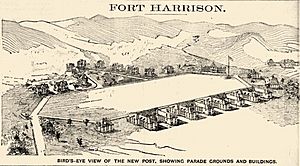
Helena's economy also benefits from Fort William Henry Harrison. This is a training facility for the Montana National Guard. It is just outside the city. The Fort Harrison VA Medical Center is also there. Many Helena residents work at these places.
Education and Learning
Colleges and Universities
- Carroll College is a Catholic college. It opened in 1909 and has about 1,500 students.
- Helena College University of Montana is a two-year college. It is part of The University of Montana. It offers degrees in skilled trades and technology. It also has general education courses. It opened in 1939.
Schools for Kids
Several school districts provide public education for students from pre-kindergarten to 12th grade. Most of Helena is in the Helena Public School District.
The Helena Elementary School District has 13 schools. They serve students from pre-kindergarten to 8th grade. In the 2021–2022 school year, about 5,181 students were in this district.
The Helena High School District has two high schools for grades 9-12. Helena High School had 1,128 students in 2021–2022. Capital High School had 1,350 students.
Public Library
Helena's main public library is the Lewis & Clark Library. It also has branches in nearby towns like Augusta and East Helena.
Media and News
Helena has its own local media.
- Newspapers
- Independent Record (daily morning newspaper)
- Online News
- Montana Free Press (statewide news)
- Radio Stations
- KKGR 680 (Oldies music)
- KCAP 950 (Talk radio)
- KROL 1430 (Classic Hits music)
- KUHM 91.7 (National Public Radio)
- KQRV 96.9 (Country music)
- KHGC 98.5 (Adult Contemporary music)
- KBLL 99.5 (Country music)
- KZMT 101.1 (Classic rock music)
- KMXM 102.3 (Adult Contemporary music)
- KJPZ 104.1 (Christian music)
- KMTX 105.3 (Adult Contemporary music)
- Television Stations
- KXLH-LD (CBS/MTN, channel 9)
- KUHM-TV (PBS, channel 10)
- KTVH-DT (NBC/Independent, channel 12)
- KHBB-LD (ABC/Fox, channel 21)
Famous People from Helena
Many notable people have connections to Helena:
- Stephen Ambrose, a famous historian and author.
- Max Baucus, a former U.S. Senator and Ambassador.
- Dirk Benedict, an actor known for The A-Team.
- Isaac Brock, lead singer of the band Modest Mouse.
- Wilmot Collins, Helena's first Black mayor.
- Gary Cooper, a well-known actor.
- Nathaniel P. Langford, the first superintendent of Yellowstone National Park.
- Myrna Loy, a famous actress.
- Colin Meloy, lead singer of the band The Decemberists.
- Sean O'Malley, an MMA fighter.
- Charley Pride, a popular country music singer.
- Thomas J. Walsh, a U.S. Senator.
Images for kids
See also
 In Spanish: Helena (Montana) para niños
In Spanish: Helena (Montana) para niños


